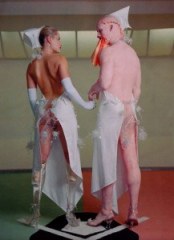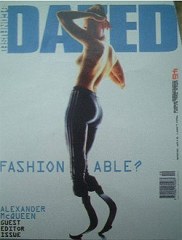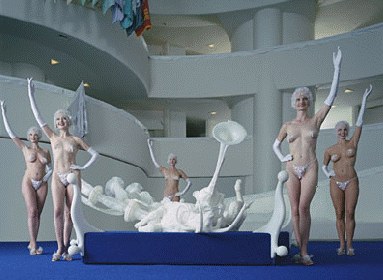|
Matthew Barney is one of the current darlings of the New York art world, thanks mostly to a five-part epic film saga called Cremaster, which is "based on the evolution of form." It is named after the cremaster, the muscle that regulates the height of the male testicles in response to temperatures or emotions, although Barney means to apply to the term to the early period of human fetal development when a life is not yet sexually differentiated. Well, anyway, that is what it is about in theory. Mostly it is a succession of images presented in dream-like free association, although the artist did have some kind of underlying narrative in mind. One critic wrote tellingly that Barney "makes Peter Greenaway look like Joel Schumacher," which translates into street American as "he is one arty-ass motherfucker." If you would like Barney's official synopsis of this nearly impenetrable work, here is the official site of the Cremaster Cycle, which summarizes each of the five parts in depth. For a shorter version, here is the Wikipedia entry which gives a nice clear synopsis, although in this case clarity presents no path to understanding or appreciation. The power and artistry of the project is in the images, so if you'd like to see a sample of what the cycle is like, here is the trailer. Finally, here is a review written by one of the few critics who has actually sat through all five films. If you would actually like to see this saga, or any of the individual parts, you'll probably have to wander to New York or Oxford or Berlin, or some other place where pretentious exhibitions are attended by artsy swells, because you won't be seeing this at your local film-n-ale. The film or films are presented in conjunction with exhibitions of related drawings, sculptures, and photographs, and there have been only two screenings of the entire cycle so far this year (2005)
Apart from these exhibitions, there is no other way to see all five films together. None of the five are on DVD in their entirety. As far as I know, there are only two ways you can see some examples of the work:
Here is the official summary of "The Order" from Barney's website:
|
||||
|
||||
 |
 |
|
||
| Depending on your attitude, you may call this project either pseudo-artistic hooey or an ambitious artistic undertaking. I think one of the New York art critics called Barney the most important living artist. You may or may not agree that he's the real thing, and you are probably more likely to despise his work than love it. I will admit that it can look impressive, and the strange images can sometimes even entertain. On the other hand, the whole thing is utterly incomprehensible and not a little bit pretentious. I assume there is some audience for this kind of material, but it must be miniscule, and I am not in the group. | ||||



